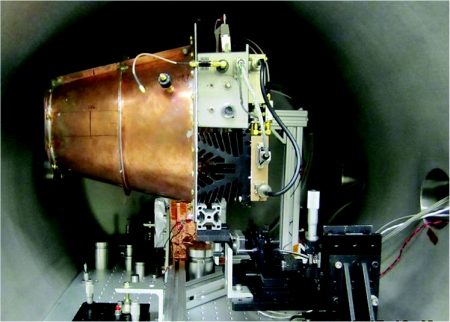November 30, 2016 – A paper appearing in the Journal of Propulsion and Power, entitled “Measurement of Impulsive Thrust from a Closed Radio-Frequency Cavity in Vacuum,” represents the first independently published and peer-reviewed verification of the workings of the EmDrive. Considered “impossible,” a propulsion system that produces thrust with no discernible exhaust and violates Newton’s third law of physics governing conservation of momentum (for every action there is an equal and opposite reaction), the EmDrive has always been considered junk science by many putting it in the same category as “cold fusion.”
Why junk science? Because Newton’s Third Law has been the one that has remained inviolable until today.
The EmDrive, first invented by Roger Shawyer, a Brit, has been subject to testing on numerous occasions. In 2012 a Chinese team published a confirmation that the drive worked but then retracted their paper when flaws were found in their methodology.
But the new EmDrive test used two variables, putting the drive on a pendulum and placing it within a vacuum. With the pendulum any observed swing would indicate the EmDrive was creating thrust. In the vacuum tube the drive was suspended.
What was observed? The EmDrive put out 1.2 millinewtons of thrust, that’s enough to accelerate an object weighing 0.45 kilograms (1 pound) to a speed of 1.6 kilometers (1 mile) per hour in 6 minutes for every kilowatt of power applied to it.
Why is this so odd? An EmDrive has no propellant. It runs on electricity alone. For space travel it means a spacecraft wouldn’t need to carry fuel as part of its payload. Solar panels or a small radioactive energy source could produce thrust.
So how does an EmDrive compare to ion engines like the one used on Dawn, the robotic spacecraft currently circling the dwarf planet Ceres? The thrust of the EmDrive is far less but the ion drive does require a fuel payload to operate.
How does the EmDrive compare to a Hall Effect Thruster, a propulsion technology that SpaceX, China’s national space program, ESA and NASA have all been trying? It provides about 1/50th the thrust. The Hall Effect Thruster still requires a fuel payload but when compared to chemical propulsion needs 80% less on board when deployed.
How does it compare to other zero-propellant propulsion systems such as the solar sail, laser and photon rockets, technologies that require no fuel payload to power them? The EmDrive provides significantly more thrust by a factor of two over solar sails but generates fractionally less thrust than the remaining two.
The authors of the study describe what they witnessed as explainable by using pilot wave theory. An EmDrive serves as a mechanism for electrons and other ionized particles to ride an external wave without application of any other external contributing force. In other words the drive acts as a medium for a physical wave within space to move a particle creating forward or reverse thrust. The position and momentum of the particle is described as a “hidden variable” following a deterministic trajectory guided by the wave within the EmDrive.
View the video to get a better understanding of pilot wave theory. Note the movement of the droplet is similar to that of an electron sandwiched between two surfaces pushed forward by a small pulse of energy from an external source. In the case of the EmDrive experiment described in the paper the external electronic input ended up producing measurable thrust data that varied based on the amount of electrical power being fed to the device.
Are there other explanations for what was observed? The authors of the paper consider several potential error sources, nine in total. One of these is thermal expansion. Doubters have pointed to thermal expansion, the tendency of matter to alter in response to changes in temperature resulting in kinetic energy. Could the EmDrive upon receiving an impulse of electricity be nothing more than a piece of metal warming creating movement of the electrons and ions contained within it? That would meet Newton’s third law.










[…] Space engine defies Newton's third law producing enough thrust to move a 0.45 kilo object from zero to 1.6 kilometers speed in 6 minutes. […]
This paper refer to many other experiments…
Many explanations have been proposed, but if ytou read the details of the cross testing done by shawyers on histes, by March in that test, it does not match.
thermal expansion is interesting and credible, until you notice that introducing dielectric on one side invert the direction.
many artifact are incompatible with test that show no thrusts out of the resonance (Shawyer and yang juan did that)…
What I dislike in general reactions is that eveybody focus on theories, criticizing the theory and not the experiment, or refuting experiment with theory.
This is for me the sign of scientific decadence…
There are tons of artifact to verify with good experiments requiring modest but real budgets (not shoestring as usual).
Also what i dislike is that most comments ignore the works of other replicators, like in china, by tajmar… his previous work too. of Fetta’s Cannae drive and his Theseus project.
and most of all even when choosing the theory they mostly ignore MiHsC which beyond Emdrive attack seriously the unscientific characteristic of Dark Matter theory.
Like on LENR when Mainstream media covers inconvenient anomalies, they show awful behaviors :
– focus on US evidences only, ignore previous experiments, foreign data… no perspective.
– focus on the worst theory, seldom on experiment. ignore better and more conservative theories.
– criticize theory not experiment, use theory to criticize experiment
– never consider that if the experiment is not perfect, thsi demand MORE budget and not LESS
I partly interpret that as lack of due diligence as it seems journalist don’t have 5 minute to google…
It is also a syndrome of academic cowardliness, where uncertainty in result imply reduction of research budget.
One can refute Newton’s laws of physics. Prior to Newton we had entirely different ideas about the way things work. And after Newton we had Einstein question Newton’s basic theories. I am sure as we try to understand and replicate physical phenomena for which our existing “laws” apply we will come to new truths.
>> that’s enough to accelerate an object weighing 0.45 kilograms (1 pound) to a speed of 1.6 kilometers (1 mile) per hour in 6 minutes
The time numbers don’t square if I am not wrong:
A weight of 0.45 Kg has a mass of (0.45 Kg weight / 9.8) = 0.0459 Kg
Normalizing speed, V = 1.6 Km/h = 1.6 * (1000/3600) = 0.4445 m/s
For a force of 1.2 mN, since F = m * v / time
time = (m * v) / F = (0.0459 * 0.4445) / 0.0012 = 17 seconds
(6 minutes is aproximately the result for a mass of 1kg)
—–
Update:
Maybe I should take the weight (a force) unit, since it is in Kg, as Kilograms-force https://en.wikipedia.org/wiki/Kilogram-force, then
time = (0.45 Kg * 0.4445 m/s) / (0.0012 N) = 166.6875 seconds = 2.778 minutes
Thanks for doing the math. The figures quoted in the posting come from the journal article describing the experiment.
This is going to be launched into space low Earth orbit less then 150 miles in the early part of 2017 by the inventor Guido Fetta, The Cannea Drive. I myself a retired Boeing engineer did my due diligences on the study of this EmDrive and all the Scientist and engineers that were involved. I am quite confident that this will work. And it will usher in a whole new age of science and discovery.